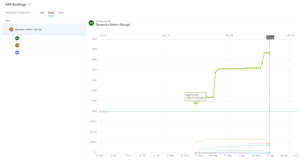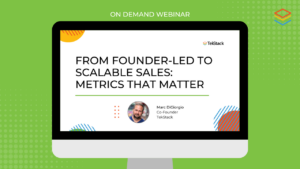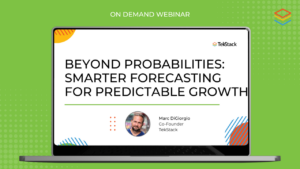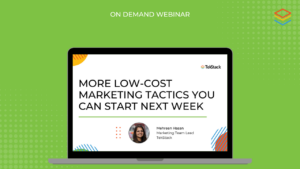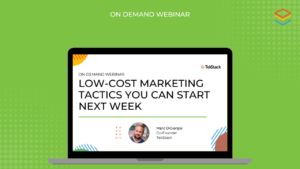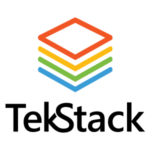
To realize success in Customer Success, we need to define what success means. Really its two-sided. On the one side, from the viewpoint of the customer, its about providing them tools and processes they need to achieve THEIR business objectives. Hopefully the product and service your company provides does just that. On the other side, from the viewpoint of your software business, it’s about keeping the customer, retention of ARR, and expansion of that ARR.
Since ARR is the most valuable of your revenue, it’s the biggest driver to your company’s valuation, existing customers become an important source of future work, referrals, and references; investing in people, tools, and processes to keep that revenue is a logical thing to do.
This article doesn’t discuss what the role of customer success is, or whether or not your software company needs a dedicated function for success. Those are big topics well treaded by others. Regardless of the approach your company takes:
- Creating a CS role through existing functions like Sales, Services, and Support.
- Create a dedicated CS function that is sales measured
- Create a dedicated CS function that focuses on delivery & support
The first place these team members will struggle is:
- Lack of access to information about the customer. The data needed to perform the role are spread across half a dozen different systems:
- Applying the same broad stroke approach across all customers. Simply, your team will run out of bandwidth very quickly.
So how do you give CSMs the info they need?
First, CSMs need instant access to customer information at their fingertips. The problem though is that most software companies have developed an internal technology stack that is function specific. The result is a mix of systems across the organization that don’t share information all that well, despite best efforts. Have a look at this typical customer lifecycle and the various tools to support it.
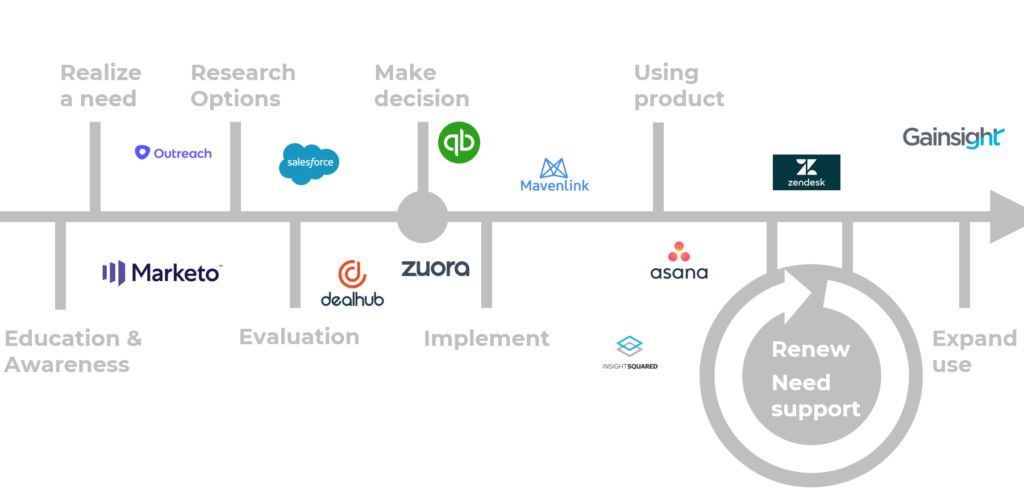
The various stages of the customer lifecycle overlaying the tech you put in place to support the process internally.
The result is a need to integrate across these tools. But this takes a ton of effort, and ends up creating a system of record for your customer in each tool. In this example, a customer record, (source of truth) will be exist in Marketo, Salesforce, Mavenlink, Zendesk, Quickbooks, Zuora, Gainsight. Which one is right?
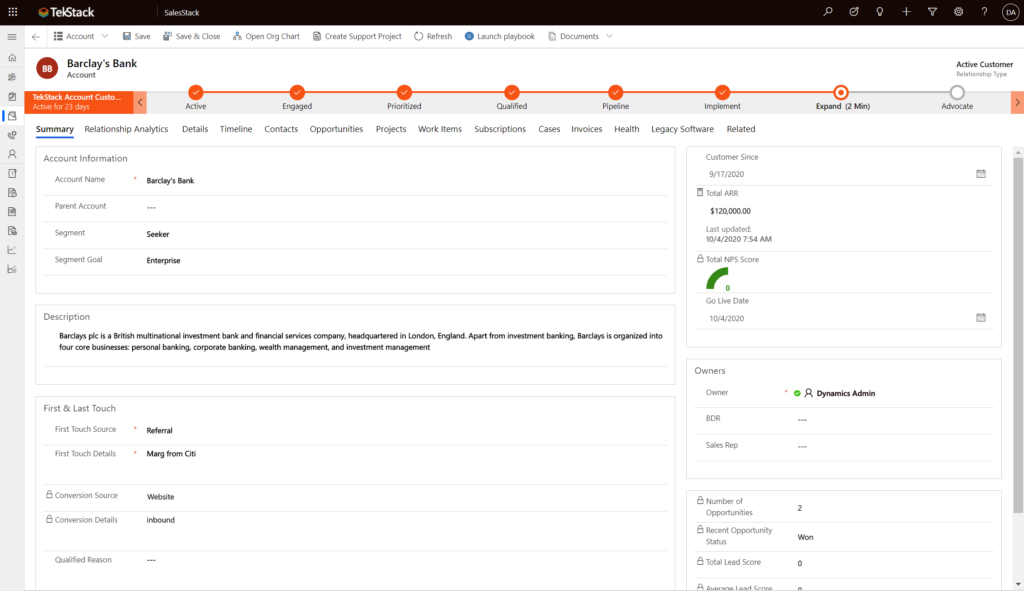
The view of the customer record includes all the information you need to support that customer.
TekStack’s approach is to have one system of record. One data source for all information across the lifecycle which makes it infinitely easier for CSMs to draw the following information to perform their function:
Contact information. Contact information changes over time, other departments are often adding or changing this information. Certain attributes need to be tracked, communication between contacts and other team members needs to be captured. Relationships between contacts and team members should be measured.
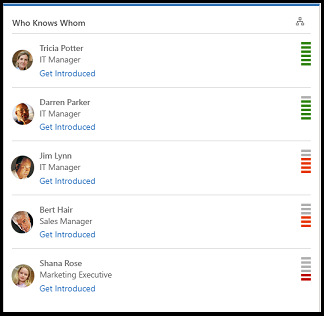
A view of who knows Whom
Timeline. A view of all the activity for an account. Emails, meetings, phone calls, key project milestones, elevated cases, upcoming renewals, web inquiries; all of it should be trackable with filters to make it easy to understand what is happening.
Relationship Analytics. Are your contacts engaging with your email? What is your response rate, what is theirs? Really valuable information.
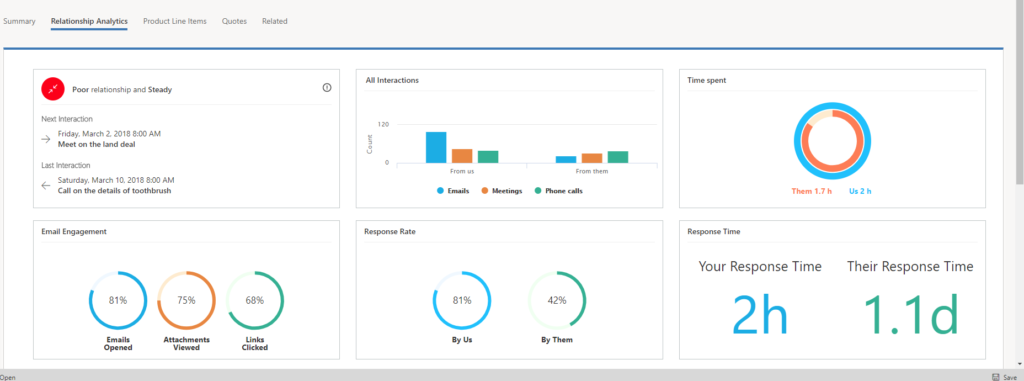
Get a gauge of customer engagement
Marketing Insights. Lead scores are equally important post sale, especially if ‘land and expand’ strategy is key to business growth. What’s marketing up to with your customer? What content are they consuming? Are they visiting the website? Usually this information is a black hole for CSMs.
Organization Changes. Is your customer hiring for a key role? Did your contact leave the organization? Companies that have subscriptions to LinkedIn Sales Navigator should integrate that insight into the tool used by the CSM.
Opportunity History. If the CSM is inheriting the customer relationship from a sales role, its helpful to know what the past sales history was. Did the scope of the deal change? If it was a reduced scope from a previous opportunity maybe that represents your first upsell opportunity.
Deal Notes. Easily capture notes from discovery, pre-sales, sales-to-service transition, project meetings. TekStack integrates OneNote to the account to provide easy access. This beats digging up Word documents scattered across local drives.
ARR & Renewal Date. What is the ARR for the customer, what is the renewal date(s), which products are they subscribed to, what quantities are they licensed for, what price did they contract at?
Invoices. Having access to invoice history, and invoice status. AR status is often the first sign of trouble.
Projects. How did the project go? Is it complete? What was the project health? Was it under/over budget?
Cases. Accessing case history and real-time access to open cases.
NPS Results. Capture NPS results, see changes over time, track responses by role.
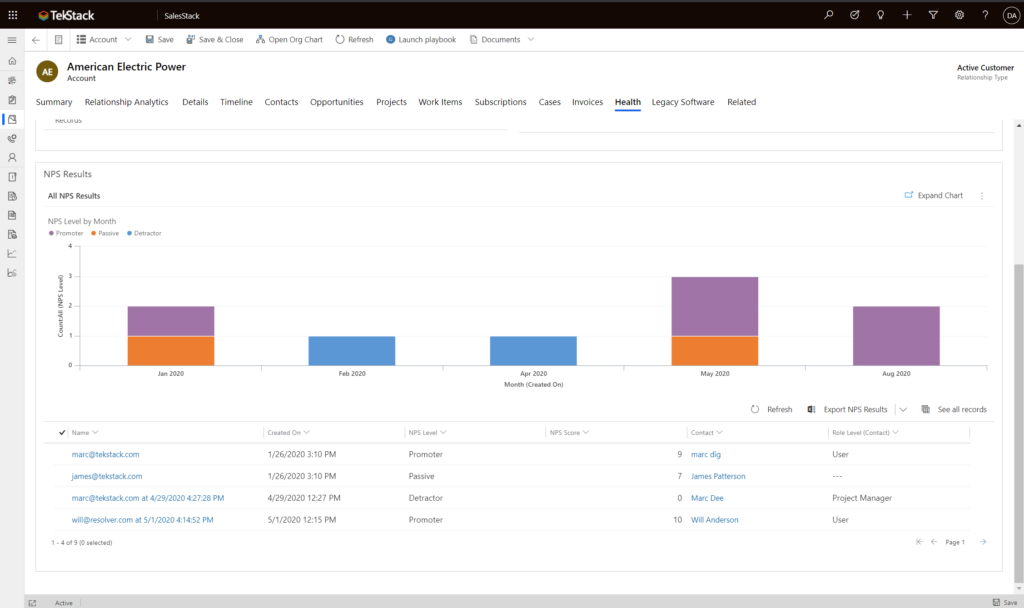
See results over time, weighting the score based on a longer time horizon
Telemetry. Data around software use. The key metrics are new admin users being added, as well as monthly active users.
Legacy Software. Other incumbent software products used by the organization. This could represent future opportunities or future threats.
Success through Focus
Its not reasonable to apply the same customer success program across all customers. Focus your efforts on:
- Customers that are engaged with you and want you to help them achieve their goals. These customers see you as a trusted advisor, a true partnership. Double down on these relationships.
- Customers that are struggling with your offering. These are at-risk customers and need your help.
And for the rest of your customer base?
Attempt to automate as much of your interaction as possible. Here are some tools TekStack provides to help with this:
Renewal Playbooks
TekStack tracks renewals as opportunities automatically creating a renewal opportunity a set number of days prior to the end of the term. With this process we kick off a playbook that automatically creates tasks for the CSM to accomplish prior to the renewal invoice going out. To see our recommendation for renewal playbooks, you can check out this link.
Automate Sales Engagement Sequences
If you have a large customer list and you want to engage with them, it often helps to run automated sales engagement sequences. These are different than marketing campaigns because they are more personalized, come directly from the CSMs email account, and give CSMs insight into customer engagement. They incorporate automated emails with other tasks like phone calls, linked in activity, and other actions. They are incredibly productive if used correctly. (ie. Not overused)
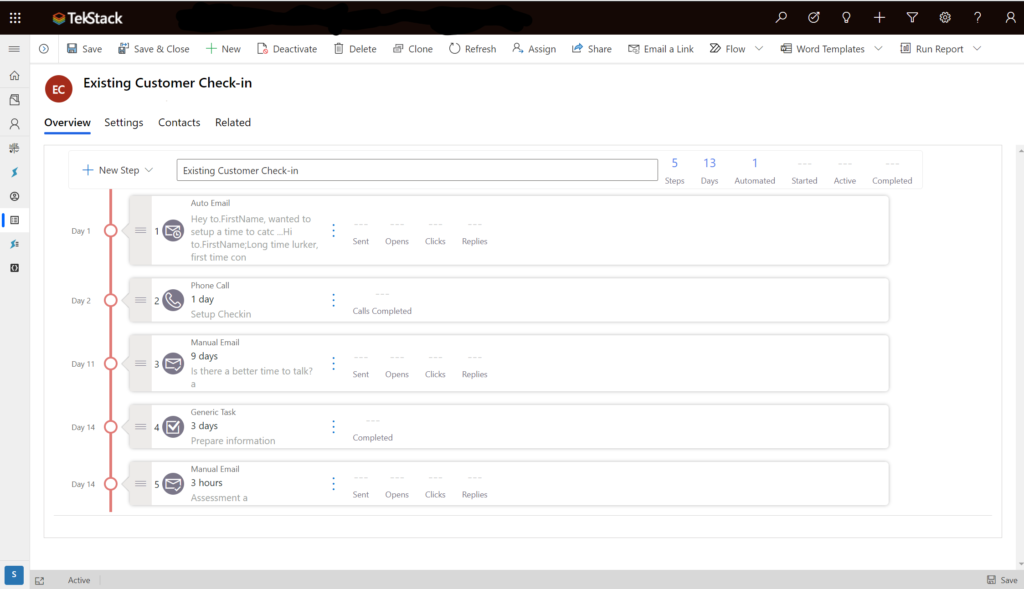
Automate activities in a sequence
Customer Segmentation
How do you determine if a customer should be put on an automated stream or highly engaged? The best way to do this is to create customer segments. Draw a grid with two axis. You want to separate out customers that are happy to have a low touch approach and just want to use your product from customers that want or need a high tough approach. The two questions I’ve asked in the past are:
- Is this customer trying to improve their current business function or are they happy with what they have? DESIRE
- Does this customer have the potential to do big things? POTENTIAL
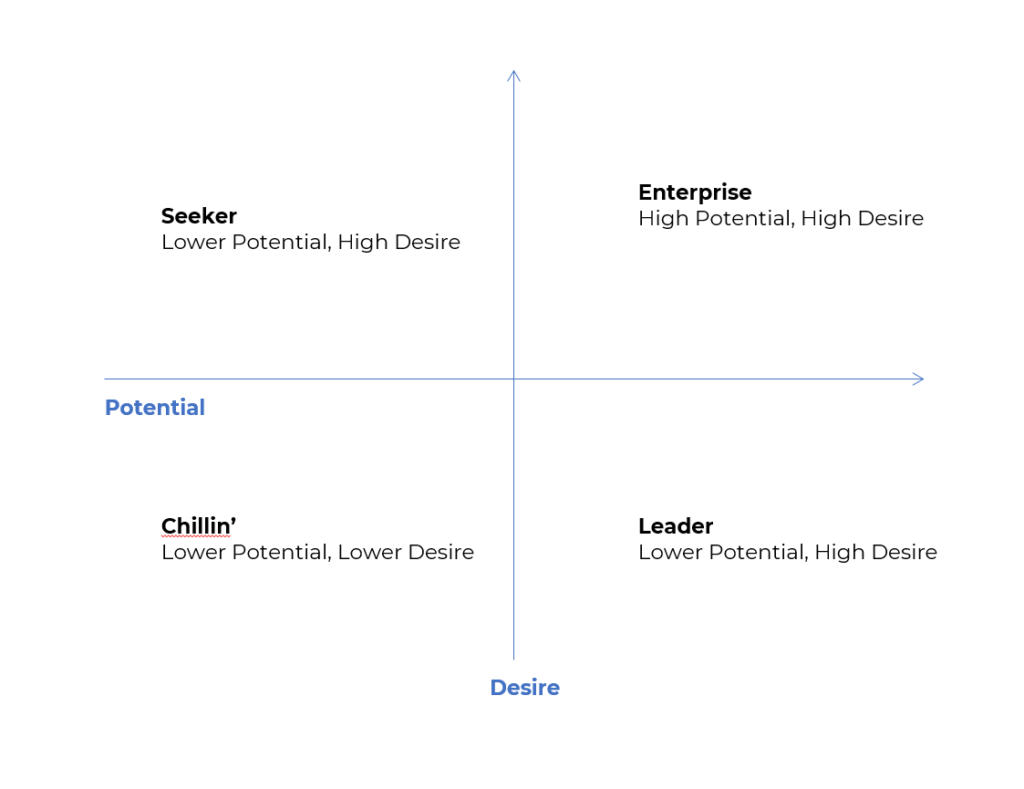
Segment your customers across two axis. Here we use Desire and Potential.
How is this all applied?
Lets walk through some hypotheticals. Reveles is a Cyber Security company. They sell to large companies, and have 500 customers. Their ARR is $15M. Average Deal Size is $25K. Their retention is 90% and Net Churn is 105%. They’ve found a new use case and want to go back to the 500 customers and look for opportunity to expand use. Reveles has decided to hire 3 Customer Success reps from their existing talent pool. They need to assign the 500 customers accordingly. Where do they start?
Segment the customers
Knowing that its impossible to have one CSR take on 160 named accounts, the team figures that 20 managed accounts per CSR is manageable. So how do they figure out which 60 of the 500 customers should be managed versus automated?
- Don’t just take the top 60 ARR customers. That could mean missing out on huge potential.
- Do ask your sales support and services team for high potential candidates.
- Get internal stakeholders to plot this list against the grid.
- If there are still more than 60 accounts in the Leader and Enterprise Segments, then go through a voting process.
- Validate this final list against firmographic information like company size and growth.
- Finally run the list against the NPS survey results to ensure there aren’t any missing opportunities
Build Automation Programs
For the remaining 440 customers, its time to build automation programs for outreach.
- Create two playbooks. Renewal Playbook, and Customer-at-Risk playbook. Start the renewal playbook with an NPS Survey 60-90 days before annual renewal date. If scores are low, kick off the Customer-At-Risk playbook. Try to minimize the amount of manual activity with the renewal playbook but keep the engagement as high as possible. Monitor engagement for opens and click thrus. Provide ample calls to action so the customer can opt in communication.
- Automate a marketing nurture program. Feature monthly newsletters with a number of self-service calls to action including product videos, release notes, webinars. Put them on the calendar and assign responsibility across your support, services, dev and pre-sales team.
Build a Managed Account Plan
- The key with an account plan is to make it mutual. What is your customer wanting/needing to accomplish this year? How do they get measured? Can you align your activity to help them achieve this?
- Make the plan action oriented.
- Think about Leading Indicators
- Scream your successes and learnings high from the rafters. Get into a cycle of reviewing your customers’ data every quarter to help them. Maybe they don’t see the things you see.
Build measurement and goals
How are you going to measure the team? To be successful in customer success, you need to snapshot your current results around retention, net churn, sales bookings, and NPS before you set goals. Measure these numbers across the managed and unmanaged accounts to see how each change. You’ll want to compare the results by segment. Align the team to these measurements and pick out leading indicators.
Give the team tools to perform their job
Give the team access to the tools and information they need. See the list above, pepper that with dashboards and reports so they can perform their job to the level the business requires.
Summary
Existing Customer revenue is critical to your company’s success. Given the high cost of sales & marketing, it can take multiple years for the Customer Acquisition Costs to be paid back. You need to retain customers for the long haul. Regardless of your strategy for ‘customer success’ within your organization, your team needs tools and data to perform their job. This is a small investment considering the labor costs you are already investing, and the opportunity cost of not getting it right.


